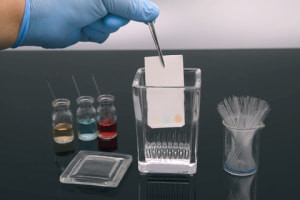When you study the fundamentals of chromatography, you will learn how this technique allows scientists to separate molecules of interest from a crude mixture. The purpose of chromatography is to separate a complex mixture into individual components exploiting the partition effect which distributes the molecules into different phases. You will find out that in cation exchange chromatography, the matric has a negatively charged functional group with an affinity towards positively charged molecules. You will be introduced to the concept of hydrophobic interaction chromatography (HIC), which exploits the ability of strong interactions between the hydrophobic group attached to the matrix and hydrophobic patches present on an analyte such as a protein. You will learn that in the presence of a high amount of salt, the water molecule shielding the protein side chains are displaced completely with an exposure of hydrophobic patches on the protein surface to induce protein precipitation or a reduction in protein solubility. You will discover that the addition of a low amount of salt to the protein solution results in the displacement of bonded water molecules with an increase in protein solubility. Demonstrations, problems, examples and assessment questions in this instructor-led video-based course, are designed to provide you with a comprehensive foundation in chromatography.
The material introduces you to the mechanisms of separation in chromatography and the different physical properties that can be used to separate molecules. Then, the proteins will be discussed, which have minimum solubility in solutions with a pH that corresponds to their Pi and they often precipitate out of solution. You will explore the fact that the molecular weight and size of a protein is related to the shape of the molecule and the relationship between its molecular weight and the radius of gyration. You will discover the fact that the retention time refers to the time it takes for an analyte to come out from the column. It will be clarified that the two major forms of chromatography are partition chromatography and adsorption chromatography. You will discover that in column chromatography, a stationary phase is filled into a cylindrical tube made up of glass or steel. You will also learn that the plot of the elution volume, along with the absorbance, is known as a chromatogram. You will find out that the term resolution, refers to the ability of a chromatography column to separate two analyte peaks from one another.
Next, you will learn that for the fast protein liquid chromatography (FPLC) instrument the plastic columns are the most appropriate to use, whilst for the high-performance liquid chromatography (HPLC) instrument the stainless still columns are the most appropriate to use. You will gain insight into the fact the size of the loop depends on how much protein you want to inject and the column capacity. You will then discover that the four properties of a protein molecule are the charge, surface area, affinity and its hydrophobicity. You will be taught that the different chromatography techniques that you can use to exploit the properties of a protein molecule are ion-exchange chromatography (IEX), HIC, gel filtration chromatography and affinity chromatography. You will discover that when preparing matrix beads for chromatography, the first step is to swell the medium, followed by the removal of very small particles and the last step is the equilibration with counter ions. Finally, you will study chromatography techniques, column connections, cation exchange chromatography buffers, and methods of analyzing eluents. This course will be of interest to students of a number of science disciplines, including analytical chemistry and biology.
What You Will Learn In This Free Course
View All Learning Outcomes View Less All Alison courses are free to enrol, study, and complete. To successfully complete this Certificate course and become an Alison Graduate, you need to achieve 80% or higher in each course assessment.
Once you have completed this Certificate course, you have the option to acquire an official Certificate, which is a great way to share your achievement with the world.
Your Alison certificate is:
- Ideal for sharing with potential employers.
- Great for your CV, professional social media profiles, and job applications.
- An indication of your commitment to continuously learn, upskill, and achieve high results.
- An incentive for you to continue empowering yourself through lifelong learning.
Alison offers 2 types of Certificate for completed Certificate courses:
- Digital Certificate: a downloadable Certificate in PDF format immediately available to you when you complete your purchase.
- Physical Certificate: a physical version of your officially branded and security-marked Certificate
All Certificate are available to purchase through the Alison Shop. For more information on purchasing Alison Certificate, please visit our FAQs. If you decide not to purchase your Alison Certificate, you can still demonstrate your achievement by sharing your Learner Record or Learner Achievement Verification, both of which are accessible from your Account Settings.











 Avg. Hours
Avg. Hours  Contains Video
Contains Video  CPD Accredited
CPD Accredited 
 Total XP:
Total XP: 
 Knowledge & Skills You Will Learn
Knowledge & Skills You Will Learn 







